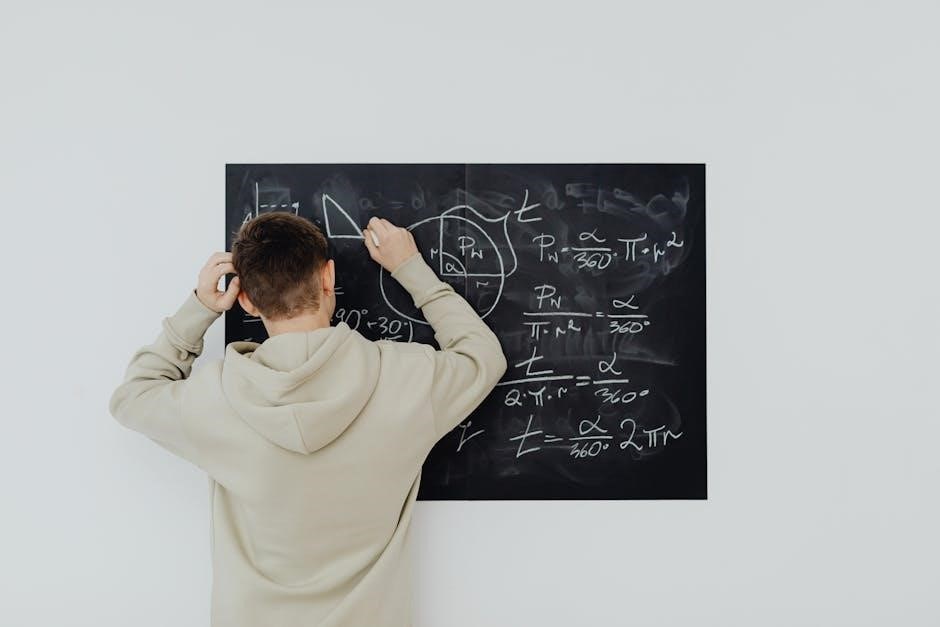This comprehensive guide provides a structured approach to understanding fundamental physics concepts, offering detailed problem-solving tools and resources for high school students and educators alike.
Overview of the Textbook Structure
The textbook “Physics: Principles and Problems” is divided into 15 volumes, each designed to cover essential topics in physics for high school students. It includes a teacher wraparound edition, chapter assessments, and a computer test bank with accompanying manuals. The structure is complemented by a laboratory manual, lesson plans, and physics lab worksheets. Additionally, the textbook features a “Problems and Solutions Manual” that provides answers to all questions in the student edition, including practice problems, section reviews, and chapter assessments. This comprehensive organization ensures a structured learning experience, catering to both students and educators with its detailed content and supplementary resources.
Key Features of the Glencoe Physics: Principles and Problems Edition
The Glencoe Physics: Principles and Problems edition is designed to empower educators and students with a wealth of resources. It features a comprehensive coverage of physics topics, an engaging presentation, and a variety of supplementary materials. Key highlights include practice problems, critical thinking exercises, and enrichment activities to deepen understanding. The textbook also includes a “Problems and Solutions Manual” that provides detailed answers to all student edition questions. Additional resources such as laboratory manuals, lesson plans, and physics lab worksheets further enhance the learning experience. This structured approach ensures that both students and educators have access to a robust toolkit for mastering physics principles and solving complex problems effectively.

Core Principles of Physics
Physics explores fundamental concepts like energy, motion, and forces, providing a foundation for understanding the natural world through universal principles and mathematical frameworks.
Conservation Laws in Physics
Conservation laws are fundamental principles in physics that describe the preservation of certain quantities over time. These laws, such as the conservation of energy, momentum, and charge, are universal and apply across all domains of physics. They provide a foundational framework for understanding complex phenomena and solving problems. The conservation of energy, for instance, states that energy cannot be created or destroyed, only transformed. Similarly, the conservation of momentum ensures that the total momentum in a closed system remains constant. These laws are not only essential for theoretical understanding but also serve as powerful tools for solving algebraic problems, unlike Newton’s laws, which often involve differential equations. Their simplicity and broad applicability make them indispensable in both classical and quantum physics.

Quantum Physics and Its Fundamental Principles
Quantum physics explores the behavior of matter and energy at the smallest scales, revealing unique phenomena such as wave-particle duality and uncertainty. Fundamental principles include quantization, where certain properties take discrete values, and the probabilistic nature of physical events. The Heisenberg Uncertainty Principle highlights the limits of simultaneous measurements, while Schrödinger’s equation describes the time-evolution of quantum systems. These concepts revolutionized understanding of atoms, photons, and subatomic particles. The Physics: Principles and Problems PDF resource provides detailed explanations and practice problems to master these abstract ideas, enabling students to apply quantum principles to real-world scenarios and advanced scientific challenges.
Problem-Solving Strategies

Effective problem-solving involves identifying knowns and unknowns, drawing diagrams, and applying fundamental principles. Practice problems and critical thinking exercises refine these skills, fostering a systematic approach to complex challenges.
Approaches to Solving Physics Problems

Mastering physics problems requires a systematic approach. Identify the given values, unknown quantities, and the physics principle involved. Drawing diagrams and outlining steps can simplify complex scenarios. Critical thinking exercises enhance problem-solving abilities, while practice problems reinforce understanding. Utilizing supplementary resources like solution manuals provides clarity and builds confidence. Regular practice with a variety of problems helps develop intuition and improves performance in tackling both straightforward and intricate challenges effectively.
Practice Problems and Solutions Manual
The Practice Problems and Solutions Manual is a comprehensive resource designed to enhance understanding and mastery of physics concepts. It includes a wide range of practice problems, section reviews, and chapter assessments, all aligned with the textbook. Each problem is accompanied by detailed solutions, enabling students to track their progress and grasp problem-solving strategies. This manual is an invaluable tool for both students and educators, providing a structured approach to reinforcing learning and preparing for assessments. By practicing with these problems, learners can build confidence and improve their ability to apply physics principles effectively.

Applications of Physics Principles
Physics principles are applied in electricity, magnetism, and energy, shaping technology and understanding natural phenomena. These applications are crucial for innovation and solving real-world problems effectively.
Electric Charges and Interactions
Electric charges are fundamental properties of matter, existing as positive, negative, or neutral. Their interactions govern phenomena like attraction, repulsion, and the structure of atoms. Coulomb’s Law describes the force between charges, while electric fields explain the influence of charges on surrounding space. These principles underpin technologies such as electronics, motors, and generators. Understanding electric interactions is crucial for analyzing circuits, capacitors, and electromagnetic waves. The Physics: Principles and Problems PDF provides detailed explanations and problems to master these concepts, essential for both theoretical and applied physics studies.
Magnetism and Its Governing Principles
Magnetism arises from the interaction of magnetic fields and magnetic materials, governed by principles such as the magnetic force on moving charges and the torque on dipoles. The Earth’s magnetic field and compass behavior are classic examples. Permanent magnets and electromagnets are explored, along with applications like motors and transformers. The Physics: Principles and Problems PDF offers detailed explanations, diagrams, and problems to help students grasp these concepts, essential for understanding modern technology and natural phenomena. This section ensures a solid foundation in magnetism, linking theory to practical applications and real-world scenarios.
Supplementary Resources

Additional materials include lab manuals, worksheets, and online platforms like MasteringPhysics, providing interactive tools and practice problems to enhance learning and teaching effectiveness.
Lab Manuals and Worksheets

Lab manuals and worksheets are essential supplementary resources for hands-on learning. They provide structured experiments and activities that align with textbook content, allowing students to apply theoretical concepts practically. These materials often include step-by-step instructions, data collection templates, and analysis guides to help students develop scientific skills. Worksheets reinforce problem-solving abilities by offering additional practice questions and exercises. Together, lab manuals and worksheets create a comprehensive learning experience, fostering a deeper understanding of physics principles and their real-world applications. They are particularly useful for educators seeking to integrate interactive and experimental learning into their curriculum design. These resources are designed to cater to diverse learning styles, ensuring engagement and comprehension for all students.

Online Platforms for Physics Learning
Online platforms offer dynamic tools for mastering physics principles, providing interactive simulations, video tutorials, and practice problems. These platforms, such as MasteringPhysics, cater to diverse learning needs by offering personalized study plans and real-time feedback. They often include virtual labs, enabling students to conduct experiments remotely, which enhances hands-on understanding. Additionally, many platforms feature discussion forums where students can collaborate and solve problems collectively. Educators can also utilize these resources to track student progress and identify areas needing additional support. Such platforms complement traditional textbooks by offering flexible, engaging, and accessible learning opportunities, making complex physics concepts more approachable for students of all skill levels.
The comprehensive use of resources like Physics: Principles and Problems and its supplementary materials ensures a deeper understanding of physics concepts and effective problem-solving skills development.
Importance of Comprehensive Resource Utilization

Utilizing a wide range of resources, such as textbooks, lab manuals, and online platforms, is crucial for mastering physics principles. These tools provide structured learning, practical applications, and diverse problem-solving exercises. Supplementary materials like the Problems and Solutions Manual offer detailed explanations and answers, enhancing understanding and critical thinking. By integrating these resources, students can grasp complex concepts more effectively, apply theoretical knowledge to real-world scenarios, and prepare thoroughly for assessments. Comprehensive resource utilization fosters a deeper engagement with physics, ensuring a well-rounded education and improved academic performance. This approach is essential for building a strong foundation in physics and developing lifelong learning skills.




About the author